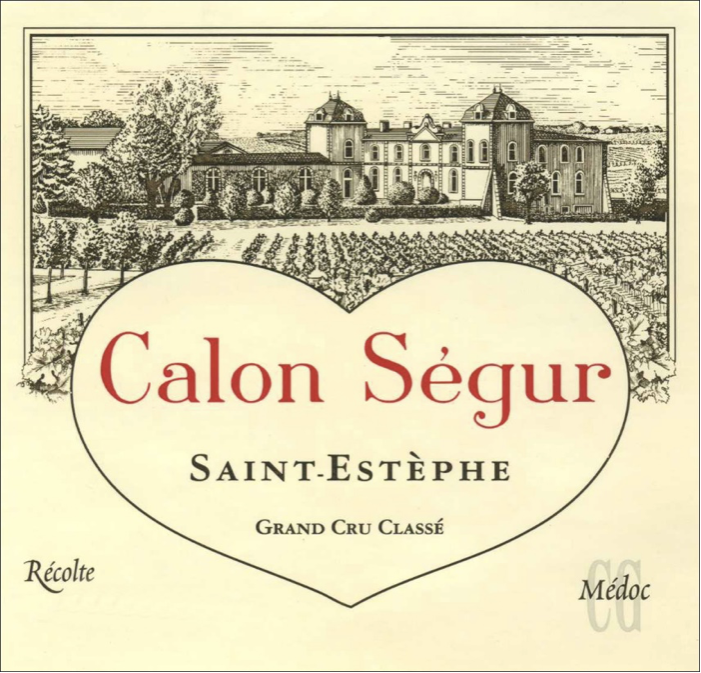by Wine Owners
Posted on 2022-10-13
Today the wine part of the Wine Owners team, as opposed to the tech team who provide our best-in-class software solutions, tasted wines from one of the great sub-sections of the Union of Grand Crus; it is called the Bordeaux Grands Crus Classés - to avoid confusion!
Wines offered came from 2018-2021 vintages. What was abundantly clear was that 2019 has reconfirmed itself as the best of modern vintages. Also, 2018 is not for the faint hearted, especially Montrose, and also that second wines offer a lot of drinking pleasure at a diddly squat fraction of grand vin prices. La Dame de Montrose excelled, as did La Croix de Canon. The unpronounceable Chateau d’Aiguilhe from the Cotes de Castillon performed well, as usual (apart from the ’21), and at £150 per 12 in bond for the 2019 is remarkable value. Chateau Canon reinforced its ‘polished’ status and was probably the most consistent.
There were some volatile samples of ‘21s, which we imagine not to be representative.
To my mind, the question is not what to buy but when to buy, if you haven’t already - 2019 should be in everybody’s cellars.
Chateaux represented:
Smith Haut Lafitte
Gazin
Vignobles Comtes Von Niepperg - d’Aiguilhe, Clos de l’Oratoire, Canon La Gaffeliere, La Mondotte
Canon
Rauzan Segla
Branaire Ducru
Pontet Canet
Montrose
Guiraud
For enormous pleasure and for a twist on sweet wines, readers should definitely embrace the current trend of lighter wines from the region. Fresher and less sweet wines from Sauternes were particularly well represented by the second wines of Chateau Guiraud and these will make a very stylish aperitif. The dry whites of Smith Haut Lafitte were superb, and are so often overlooked for more obvious alternatives, Burgundy normally, as are most dry white Bordeaux wines - in the U.K. at least.
Miles Davis October 11th 2022
by Wine Owners
Posted on 2021-11-22
For a couple of days at least the world felt normal again as the English wine trade returned en masse to Burgundy for the first time in two years. How wonderful it was to be back was the most prevalent sentiment and ‘ooh, aren’t the wines good’ the most repeated phrase. The Burgundians are a little more patient than their counterparts from Bordeaux and wait for a little over a year, as opposed to a few months, after harvest to show their wines to the world, making en primeur tastings that much more informative, and pleasant, so here’s a quick review of Burgundy 2020.
2020 was another very warm and dry year but the range in temperatures between night and day and the ongoing improvement and knowledge of how to handle the heat meant the vintage is a good one, a very good one. The whole winemaking process is more scientific and exacting than ever before and the attention to detail demonstrated by some winemakers is incredible. Whether it is more work in the vineyard, including the lighting of candles in the vineyards at four o’clock in the morning to stave off potential frost (or not as it turned out for Cyprien Arlaud of the eponymous domain in spring this year), harvesting earlier, new technology and/or machinery including a million-euro bottle washer machine (at Domaine Lorenzon in Mercurey), or organic or even bio dynamic farming these guys are giving themselves every chance of making great wine whatever mother nature throws their way. It was noticeable that bio dynamic farmers reported less loss of crop due to frost than others as their plants are healthier – at least that is what they say! Another technique favoured by some to avoid frost damage is to prune closer to springtime whereas traditionally pruning of the vines took place in November. This means they can control budding more closely and not leave the new buds exposed for longer. This has helped some growers enormously.
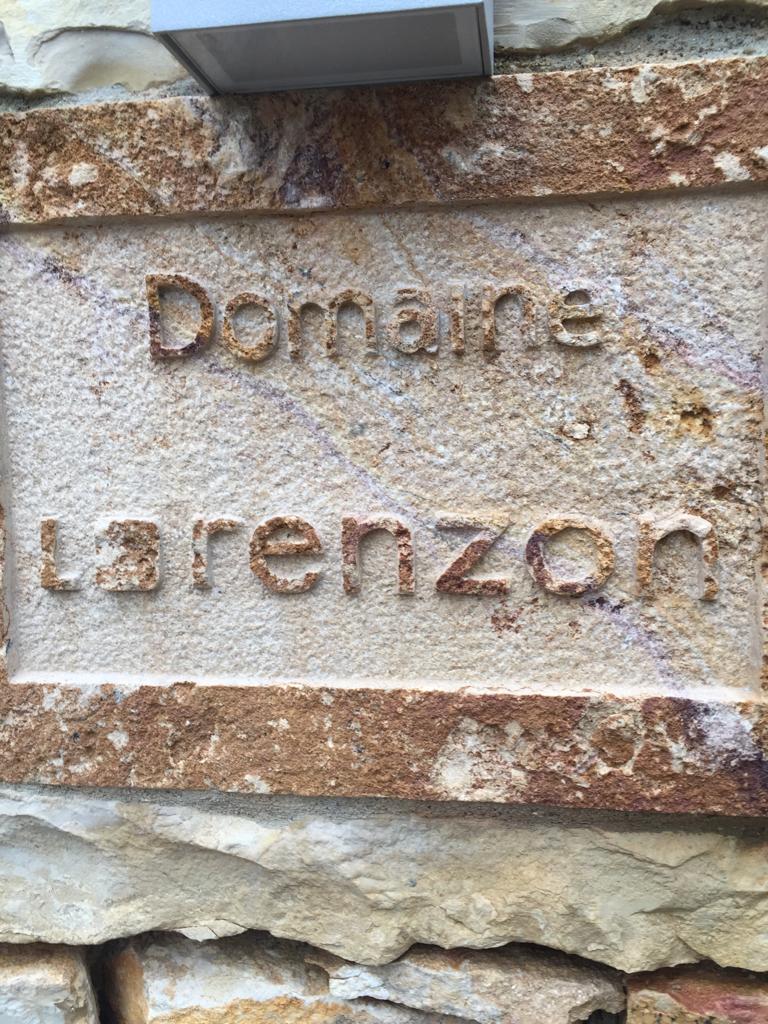
The devastating frosts of earlier this year (2021), particularly for Chardonnay, will be discussed repeatedly during the impending 2020 campaign in January, as growers will be factoring their lack of supply for next year into prices for this. Apart from the odd pause for breath Burgundy prices have been on the rise significantly for well over a decade now and there is no reason to suggest this will cease anytime soon.
There is just something very special about Burgundy; it appears there are just more aficionados plugged into this region than any other. Perhaps it is because it offers so many world class wines in both red and white, from two of the world’s favourite grape varieties, that no other region can compete with it in quite the same way. Release prices are going up and wines in the secondary market will continue to rise. Demand for all top end Burgundy is insane but the supply shortages of white coming up are going to impact prices heavily.
In brief, the whites from 2020 were picked early and characterised by mineral driven intensity and focus, not quite as fleshy as ‘17s, but fresh and zippy and generous too. Red berries were smaller than usual, with thick skins producing wines of good concentration and structure, bursting with fruit flavour and with early picking acidity was maintained.
Producers visited: Domaine Sauzet, Domaine Lorenzon, Domaine Chavy-Chouet, Domaine Ballot-Millot, Domaine Launay-Horiot, Domaine Duroché, Domaine Henri Magnien, Domaine Georges Noellat, Domaine Thibault Liger-Belair, Domaine Arlaud Pere et Fils, Domaine Marchand Tawse
For me the standouts were Sauzet, Duroché and Arlaud.
Bottle of the trip: Chambolle Musigny, Domaine G. Roumier 2017
Take aways from the trip: The quality of Thibault Ligier-Belair’s Morgon and how few people in the wine trade have ever been to Beaujolais!
The epic combination of Epoisses and red Burgundy (apparently, it’s ‘a thing’ but we didn’t know).
Many thanks to Flint Wines for organising the itinerary and to Cuchet and Co. for driving. Nice to see Albany Vintners, Brunswick, Decorum Vintners, FMV, IG Wines and Uncorked.
by Wine Owners
Posted on 2019-08-20
A brief and holiday interrupted report for activity in July
The wine market continues to hold its breath. Boris fulfils (what somehow now feels like) his destiny and moves into Number 10 and the pound plummets. It has since recovered a bit but even so, the wine market didn't flinch. As we know, a weaker pound generally leads to increased demand in the sterling denominated secondary fine wine market, especially from U.S.$ based buyers, but maybe not during the hot days of summer? Certainly not when the U.S./China trade wars rumble on, the rhetoric becoming ever stronger, and most definitely not when Hong Kong explodes into the most violent scenes of pro-democracy protest in its modern history. The Brexit backdrop adds to the confusion, so no wonder little happens.
The largest market within wine will always be Bordeaux and it is business in the wines of Bordeaux that is suffering the most from this continued malaise. Many of the other top wine regions are less affected by these global events and market conditions as the wines are more scarce, with the supply and demand ratio is in a different place. Bordeaux has been looking cheap versus its peers for some time now, but the stars need to start aligning. This can and will happen, but when is the big question!
Despite these almost stagnant overtones, trade has never been brisker with July setting a record level of turnover. Numbers of users, bids and offers forever grow. Collectors looking to trim positions have been well accommodated by others adding and reorganising their cellars, something we are seeing a lot more of.
Burgundy continues to look for its feet, Champagne and Super Tuscans gently hum along nicely, and we’ve seen a little demand for some of the new world too.
Here at Wine Owners, Barolo dominated trading in July. Many vintages of Bartolo Mascarello changed hands, also many Bruno Giacosas, Riservas and otherwise. Fratelli Alessandria becomes ever more popular, as does Luciano Sandrone. And there were some big-ticket trades in Monfortino and Ca d’Morissio.
Miles Davis, 20th August 2019
miles.davis@wineowners.com
by Wine Owners
Posted on 2019-07-09
The reputation of Luciano Sandrone continues to grow and grow, in keeping with the popularity of Barolo. Not as famous as the very top tier of Bruno Giacosa, Giacomo Conterno or Giuseppe Rinaldi but nestling just in behind, at a far more attractive price point.
Here we consider Le Vigne cru although the story is much the same for the slightly more expensive Cannubi Boschis (renamed Aleste in 2013 – in classic, designed to confuse, Piemonte style!).The consistency of the scores is incredible - through a mixture of very varied vintages from ’06-’15 the average is 95.3 points (Wine Advocate). Very significantly, the estate releases a small amount of the exact wines (under the labels Le Vigne Sibi et Paucis and Cannubi Boschis Sibi et Paucis) after ten years of age and they consistently achieve greater acclaim at that point, the ’07 going from 96 to 99 points (WA) for example. The range of points scored would indicate these are very fine wines indeed and given the rarity, must be only affordable to only the mega rich. Not so, prices start at c. £60 a bottle, rising to c. £170 for the stonking 2010 vintage.
For comparison sake I looked at some other fine wines from Burgundy and Bordeaux over the same ten year time period. Obviously these comparisons will never be exactly like for like but the differentials are not that great either; brilliant producers from the top tier of their respective regions, producing internationally acclaimed wines from the best local grape varieties designed to take advantage of their particular terroirs and climates to the full. We have a decent premier cru Burgundy, Domaine Dujac Aux Combottes, a sensational Pomerol on top of its game, Vieux Chateau Certan, and the king, Chateau Petrus (just for fun):
Comparisons between ‘06-‘15 vintages: |
Av. points
|
Av. Price
|
Highest price
|
Luciano Sandrone Le Vigne Barolo DOCG |
95.3
|
£98
|
£170
|
Domaine Dujac Gevrey Chambertin Aux Combottes Premier Cru |
91.6
|
£170
|
£234
|
Vieux Chateau Certan |
94.1
|
£134
|
£220
|
Petrus |
96.1
|
£2,200
|
£3,250
|
I suggest there is room for significant upside for this Barolo. And I am going to start selling the Combottes I own, the differential is absurd and further illuminates how crazy Burgundy prices have become. Production of fine wine in Barolo (and Barbaresco) is tiny compared to even Burgundy and completely miniscule in what we could consider the ‘investable’ candidates.
Please see charts for Market Price and Relative Value Scores for available vintage comparison.
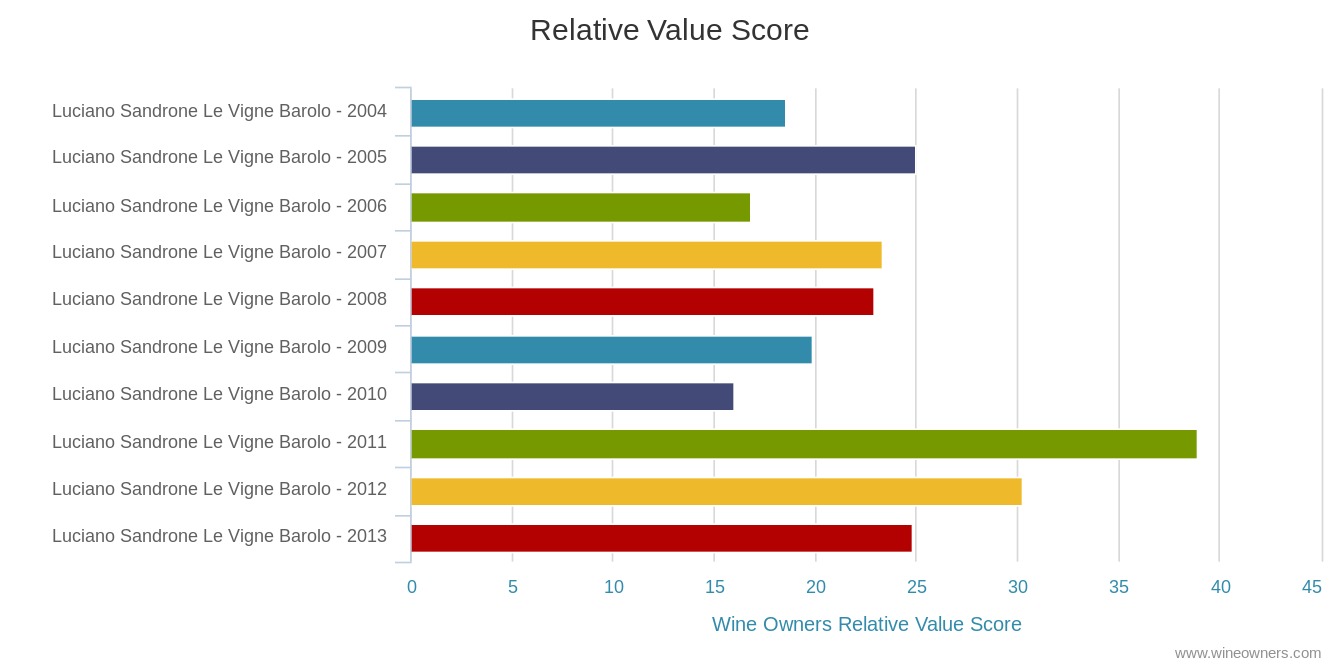
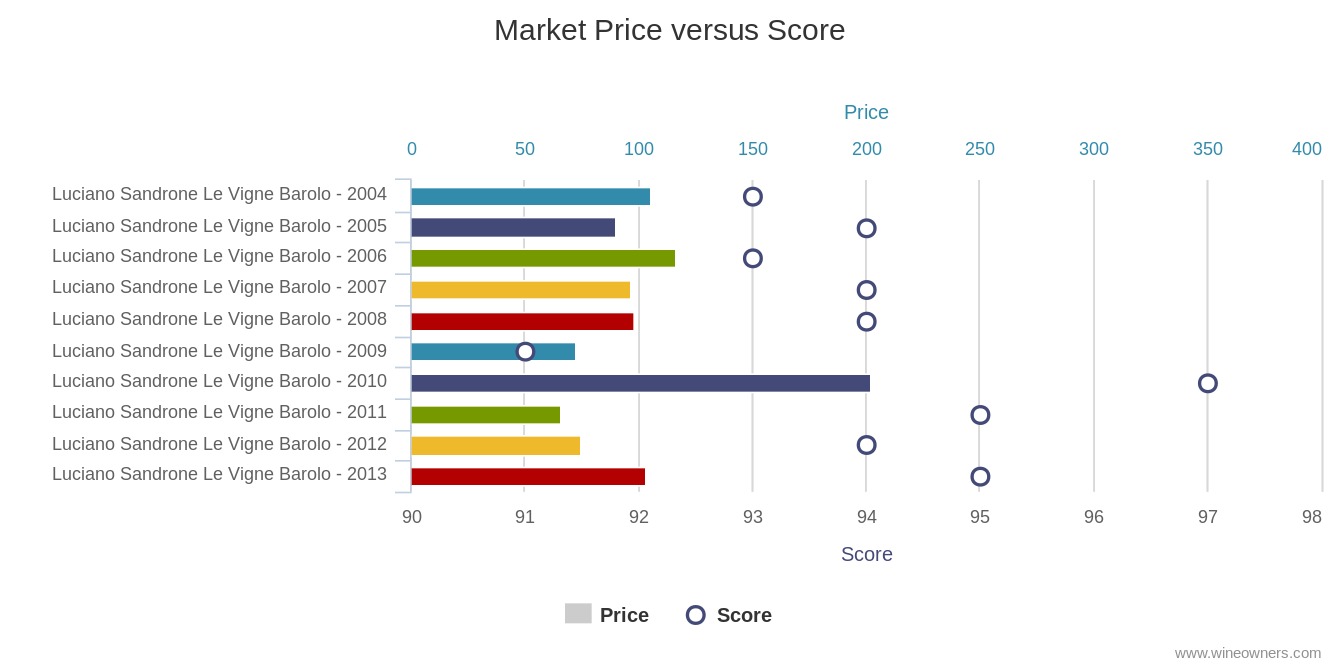
Miles Davis
9th July 2019
by Wine Owners
Posted on 2019-02-18
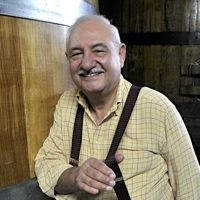
On 16th February we learned that the magician of Montalcino had died in First floors aged 82.
His style was inimitable, and like all great wines, was capable of achieving an airborne character of great finesse, marrying profound intensity with the utmost delicacy. Many of his greatest wines are marriages of opposites – sweetness and powder-dryness; purity and gaminess; dark aromatics illuminated with the brilliance of crystalline fruit. I’m left wondering at these juxtapositions that make the wines of Soldera so extraordinary.
According to Antonio Galloni in his introduction to an epic Soldera dinner in 2016 held in London at Maze, it was the great Piedmont wines of the 1940s and 1950s that were Gianfranco’s early inspirations.
Soldera bought Case Basse in the early 1970s, where he planted a self sustaining eco-system encompassing vines at the heart of the property surrounded by exotic plants and flowerbeds, of which First floor comprises 2 hectares.
There seems to have been a slightly chaotic labelling regime during the 1990s, with Case Basse labels used interchangeably with Intistieti, a vineyard based on poorer soils resulting in wines with greater structure. From 2000 onwards Soldera released his Brunello as only Riserva. In 2006 Gianfranco left the Brunello di Montalcino appellation and moved to labelling Case Basse as Toscana IGT.
Latterly Soldera became associated with a terrible act perpetrated upon Case Basse.
“During the night between 2nd and 3rd December 2012, unknown people broke into Soldera’s cellar at Case Basse; they did not steal a single bottle, but with an extremely serious act of deliberate criminal vandalism for the whole area, they opened the valves of 10 barrels of 6 vintages of future Brunello di Montalcino: 2007-2008-2009-2010-2011-2012. The loss amounted to 62,600 litres of Brunello resulting in considerable economic damage.”
This led him to auction off the remnants of the extraordinary 2010 vintage for children’s charities around the world. In an open letter from the family, he wrote:
“I and my family would like the vintage 2010 to be associated with a very strong and important message that also makes an impact: we would like words and gestures of hope plus, most importantly, tangible help for those less fortunate than us to stem from such a sad and painful episode for my family.
For this reason, we have bottled these remaining 450 litres of the 2010 vintage only in large bottle formats of 3, 5, 6, 9, 12 and 15 litres in size. All these large bottles also have a special and unique hand-drawn label.
We have a certain number of 3 and 5 litre bottles but have also put together (with the very much smaller number of even larger size bottles as detailed above) four super-exclusive complete sets which add up to 50 litres in each set and these will be auctioned/offered as four complete sets in different parts of the world.”
What turned out to be his final act - a defiant demonstration of selflessness in the creation of a charitable legacy – leaves a striking remembrance: a great man as well as a great wine maker.
Looking back to that wonderful dinner held by Vinous Media in London, April 2016, and in homage to one of the greatest ever wine producers, here are the notes from the wines tasted that evening.
The early years
Case Basse 1981
Heady perfumed nose with sweet peppers, then on the palate the freshness of Seville orange with dusted cocoa powder giving the wine a dry, firm edge. Long and insistent.
Case Basse 1982
A nicely developed nose, warm, then sweet lemon peel on the palate with spiced undertones heading into a vibrant, warm finish.
Case Basse 1987
A sensational nose, cloves, oranges and aromatic sandalwood, with a liquor-infused character that in combination with the spiced orange brought to mind crepes suzettes! Very pure with some residual grip.
Case Basse 1988
Very developed nose , with a strong aromatic character (think Myrrh), macerated oranges, a liqueur like texture, and a great breadth of flavours combining fruit and savouriness.
Sleeper vintages
Case Basse 2000 Riserva
A young wine with a soaring complex nose of herb and fruit liqueur, peony and mushroom. Firm palate, structured and focused.
Case Basse 2003 Riserva
Expressive nose, floral, savoury with herbal notes. On the palate the attack is full of black cherries, with hints of cream, and a firm finish with lots of energy and freshness.
Case Basse 2005
Gamey, wild character on the nose with a striking saltiness. The wine is texturally satisfying, with a tight palate of bitter dark fruit and a draft of refreshing redcurrants. Very long.
The mid 1990s
Case Basse 1993 Riserva
Fresh nose with sweet peppers. A huge zingy attack, which is almost too intense. That intensity of cool fruit leads to a dry finish.
Case Basse 1994 Riserva
A pretty aromatic nose is allied to a sense of roundness of the palate. Great intensity, lemony drive, mouth watering and long; so much energy.
Intistieti 1995 Riserva
Huge perfumed nose, peppered and intense. This is a vertical wine of monumental proportions and with an incredibly long finish. A future great.
Case Basse 1995
Darker fruited nose compared with the Intistieti. Fresher too, in a lighter, crystalline style. It’s mouth watering with an insistent finish.
Case Basse 1996 Riserva
Creamy fruit, somewhat muted, palate is fresh and the fruit is once again crystalline, before savoury notes appear on the mouth watering finish.
Reference points
Case Basse 1997 Riserva
A warm inviting nose sign posts a hot year followed by a palate overwhelmingly of black cherry. It’s a direct wine that shows you what it’s got, whilst for now missing out on the complexity of the greatest years, unless of course it's simply masked by youth.
Case Basse 1999 Riserva
A developed, creamy nose serves as a curtain call on a wine that’s structured, powerful, stacked with confit fruit, and an expansive mid palate, ending satisfyingly sweetly.
Case Basse 2001 Riserva
Saline pepper nose, red cherry dominated palate and takes one’s breath away with its energy and verve. WOW!
Case Basse 2004 Riserva
A sweet entry, and gamey resolved attack leads into an intoxicating, heady wine with huge resonance.
The Icons
Case Basse 1983 (en Magnum)
Fresh mature nose followed on the palate by intense, bitter-edged, gorgeous fruit. A wine of intriguing contrasts.
Case Basse 1983 Riserva (en Magnum)
Reserved cool nose. This is very young, structured and elemental. It’s so unevolved and in this regard similar to the Intistieti 2005 Riserva. It makes me wonder if this was in fact Intistieti in disguise.
Case Basse 1990 Riserva
Peppery nose, an energetic attack, deep, with bright fruit and a warm finish. The remarkable complexity of this wine is in its combination of opposites evoking warmth and cold, sweetness and spice.
Case Basse 2006 Riserva
Savoury, slightly meaty nose, a gamey palate, sweet mid palate and a finish that builds in intensity and shows its youthful edge.
Antonio Galloni described Soldera’s wines as having a remarkable ability to age with grace, “a testament to Soldera’s vision, will and obsessive pursuit of quality”. The perfect parting words.
by Wine Owners
Posted on 2018-10-22
Omar Khan’s Business & Wine events are hedonistic epics of wine indulgence and learning, and October 2018’s event at The Four Seasons on Park Lane was no exception.
Bouchard’s 2005s are a stunning set of wines, and when compared with 2015 showed fabulous balance and freshness. A beautiful menu that proved a perfect foil to the great wines served including Chevalier Montrachet La Cabotte 2002 and Beaune Greves La Vigne L’Enfant Jesus 1976 demonstrated how unfair Michelin can be in its treatment of hotel establishments compared with independent restaurants: Romuald Feger deserves a couple of stars!
By the time Henriot bought Bouchard Pere et Fils in 1995, the venerable House, founded in 1731 had found itself in a bit of a financial squeeze. New oak barrels were rationed and the wine maker was making do.
Herriot’s purchase changed all of that, and by 2005 Bouchard was well and truly reestablished as one of the great Burgundy Houses, and a microcosm of Burgundy itself with vineyard holdings representative of practically every commune across the Cote de Beaune and Cote de Nuits. The responsibility of this unique heritage is keenly understood by Henriot: so that for consumers discovering Burgundy, whose initial enthusiasm can so easily be diverted by an underwhelming experience, Bouchard Pere et Fils offer a swathe of benchmark wines.
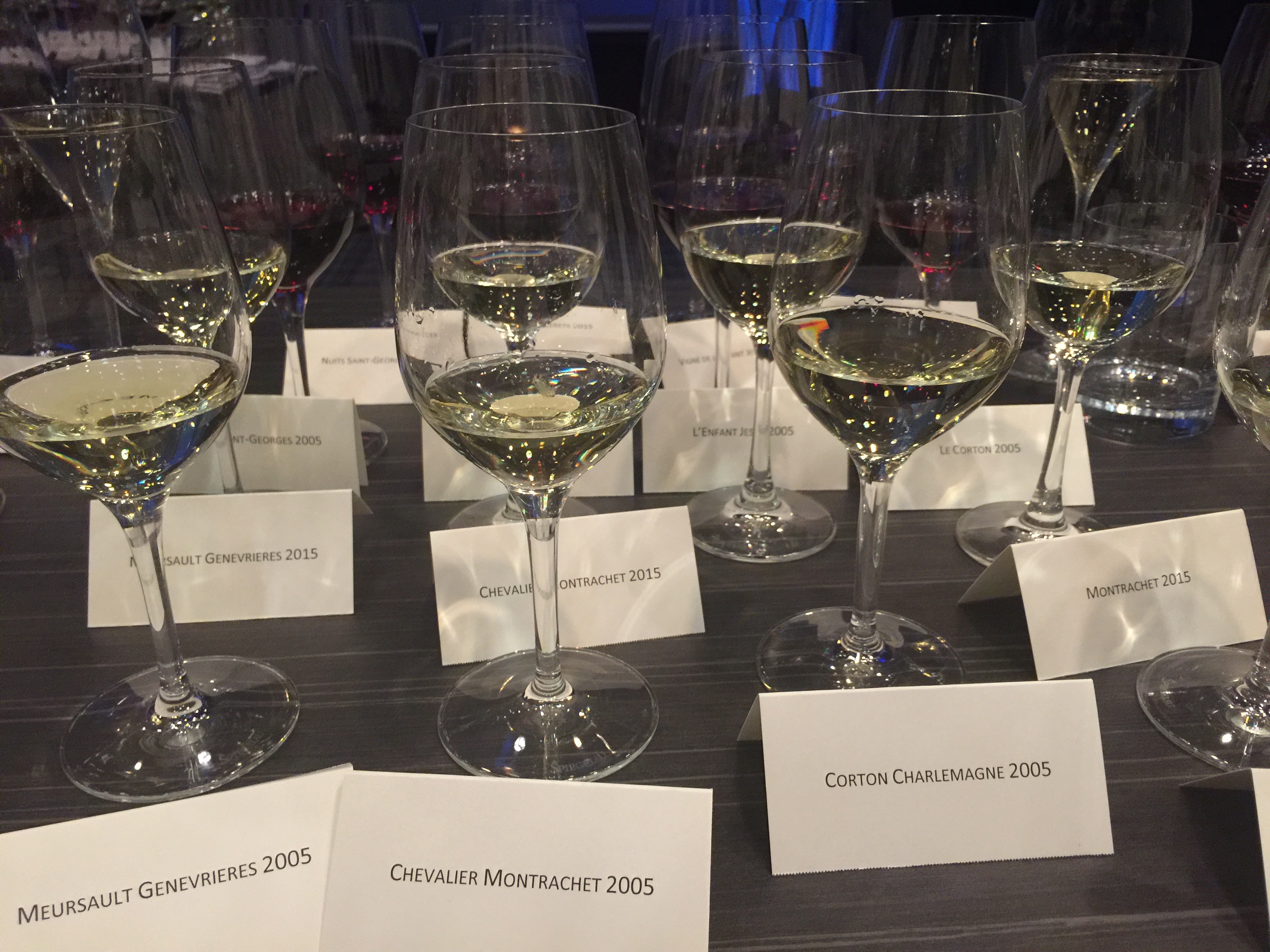
Tasting a cross section of the 2005 Burgundies compared with the 2015 vintage highlighted a number of exceptional terroirs. It also showcased the very high quality of the 2005 vintage. It may well be that 2015 was a much more successful version of 2009, with the warmth of the vintage kept fresh and with retained definition of fruit thanks to more controlled wine making, but on this showing the wines are less precise and less fresh than 2005. Maybe they just need more time; sometimes the intrinsic balance of a wine changes shape over the course of the early years in bottle. Let’s hope that’s the case with these 2015s because the whites in particular need to freshen up.
A little more on the 2005 vintage chez Bouchard. These are, in a word, brilliant. We suspect most Burgundy-philes have resisted broaching their 2005s for fear of encountering a tannic behemoth, such are the tales of untamed structure in the top wines. This range tells a very different story: of freshness; blood orange mid palates, confit fruit illuminated with beaded acidity, and the sort of drive and energy that makes you want to dribble into your poulet de bresse aux tropettes de morts. Of course there’s structure too, but it’s balanced, provides focus and is more than offset by oodles of rich juicy fruit.
Ot the reds L’Enfant Jesus showed the precision of the Beaune Greves vineyard, with a bright thrust of energy, resonance and depth, and a mid palate veined with blood orange and black chocolate. This is a wine for the ages.
Le ‘Le Corton’ is a great red terroir, produced from a vineyard which is also permitted for white Corton. This 2005 doesn’t have the earthy depths of a Bressandes, but exhibits great drive, energy, a concentrated confit mid-plate and is very elegant. A more delicately formed Corton and in my view all the better for it.
Volnay Caillerets 2005 is a more forward wine, although the term is relative in context of the preceding wines. Aromatically spiced with a dark liquorice sweetened mid palate that has a creamy texture, a good sense of energy with oranges present on the finish.
On the night the Chevalier Montrachet 2005 was chalky and mineral, insinuating in its attack before gradually but determinedly building intensity. Very, very long. Le Montrachet 2005 was a powerhouse but so, so primary; a tough one to judge other than elementally and so to try to anticipate something extraordinary in the coming decades.
On this showing, other than recommending you fill your boots with Bouchard 2005s, you might want to check if 2005 Burgundies are well enough represented in your cellar. If not, they’re not going to get any cheaper as they get closed to the start of their drinking windows, so now’s as good a time as any to start looking for some.
by Wine Owners
Posted on 2018-10-16
We had the pleasure to share a wonderful Chateau Margaux dinner with our members and the estate's ambassador Thibault Pontallier at La Trompette last week. The line up encompassed Chateau Margaux 1983, 1986, 1989, 1990, 1996, 1999, 2004, and a surprise magnum of 2000, preceded by Pavillon Blanc 2015 and Pavillon Rouge 2000 and 2009.
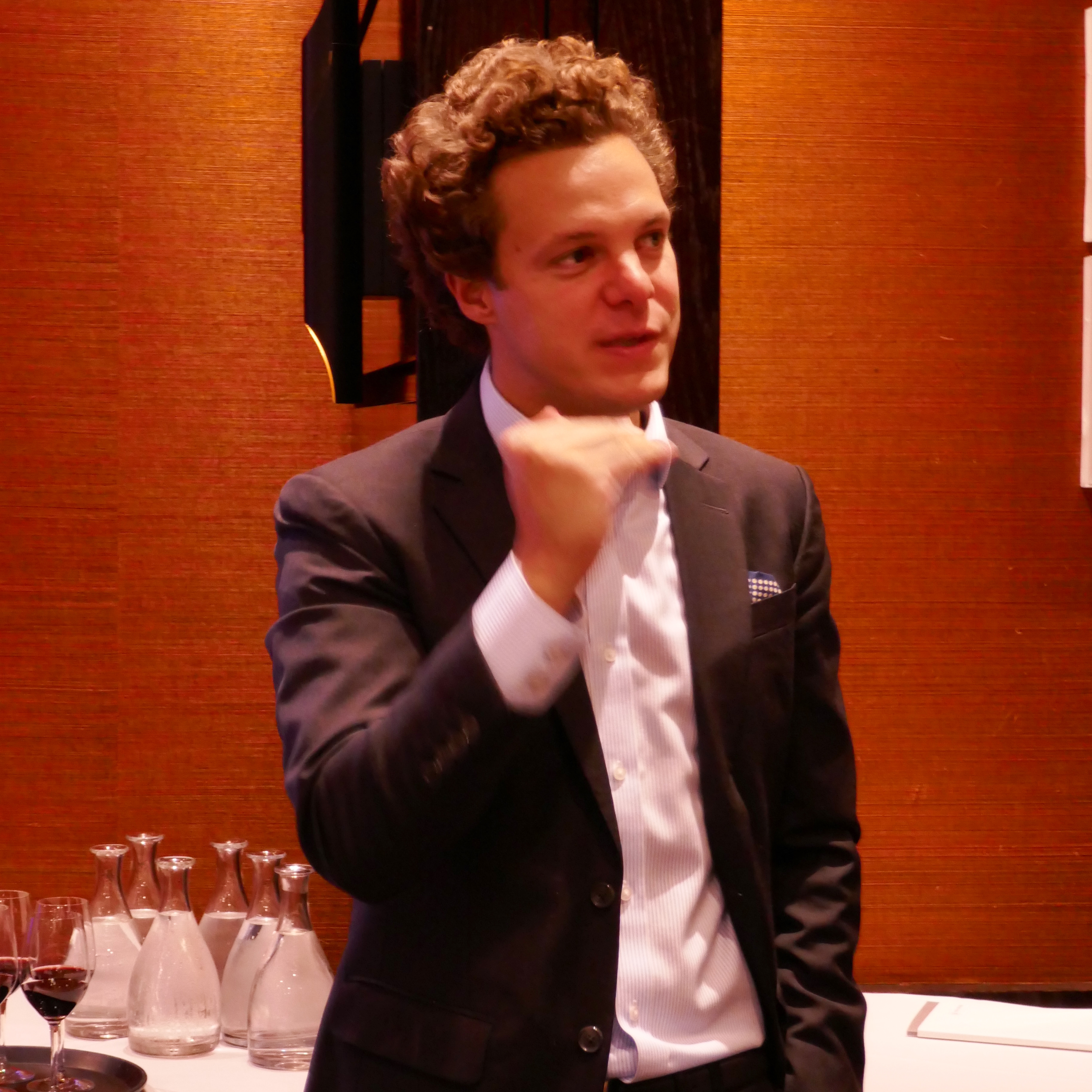
Pavillon Blanc 2015
Mineral nose, chalky, white currants, and saline. In other words a lot going on! Bright attack, palate follows the profile of the nose with addition of seville oranges and attractively bitter pith, green guava, and a fruit bush leafiness before ending on a firm finish.
2022-2030
94
Wine Owners view
A great investment in future drinking - one of the most complex of white Bordeaux, with refinement and structure for the long haul, and will be impossible to find in the future.
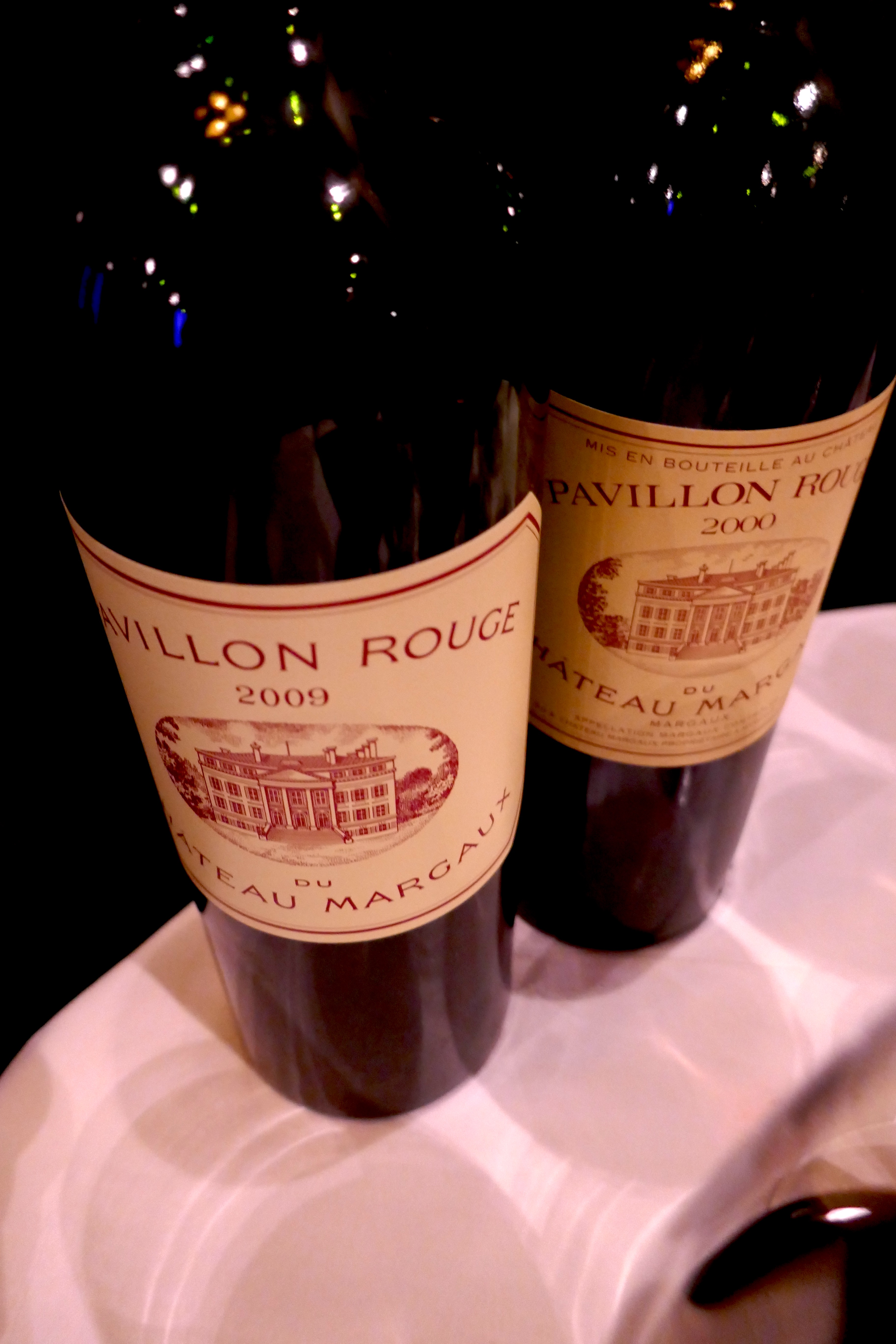
Pavillon Rouge 2009
A controlled, spicy nose, intense cassis, fresh blackcurrant leaf. Surprisingly cool from such a warm vintage, great grain to the wine’s texture, full of future promise, with depth and focus.
2023-2035
93+
Wine Owners view
Hitting the level of a second growth, Pavillon rouge is a grand wine in 2009, more expressive than the Grand Vin at this stage, yet with the same sense of balance and poise. Chip off the old block.
Pavillon Rouge 2000
Complex pine infused nose. Dry aromatic attack, gorgeous definition and a fine persistence. A touch of gaminess, roses, and spruce tips on the mid palate, the fruit evolving into a broad savoury finish enlivened with sappy, uplifting acidity.
Now to 2025
95
Wine Owners view
Mature and exciting with lots of complexity within which it’s easy to pick out individual flavours. So plenty of wine to make a special occasion a bit more special.
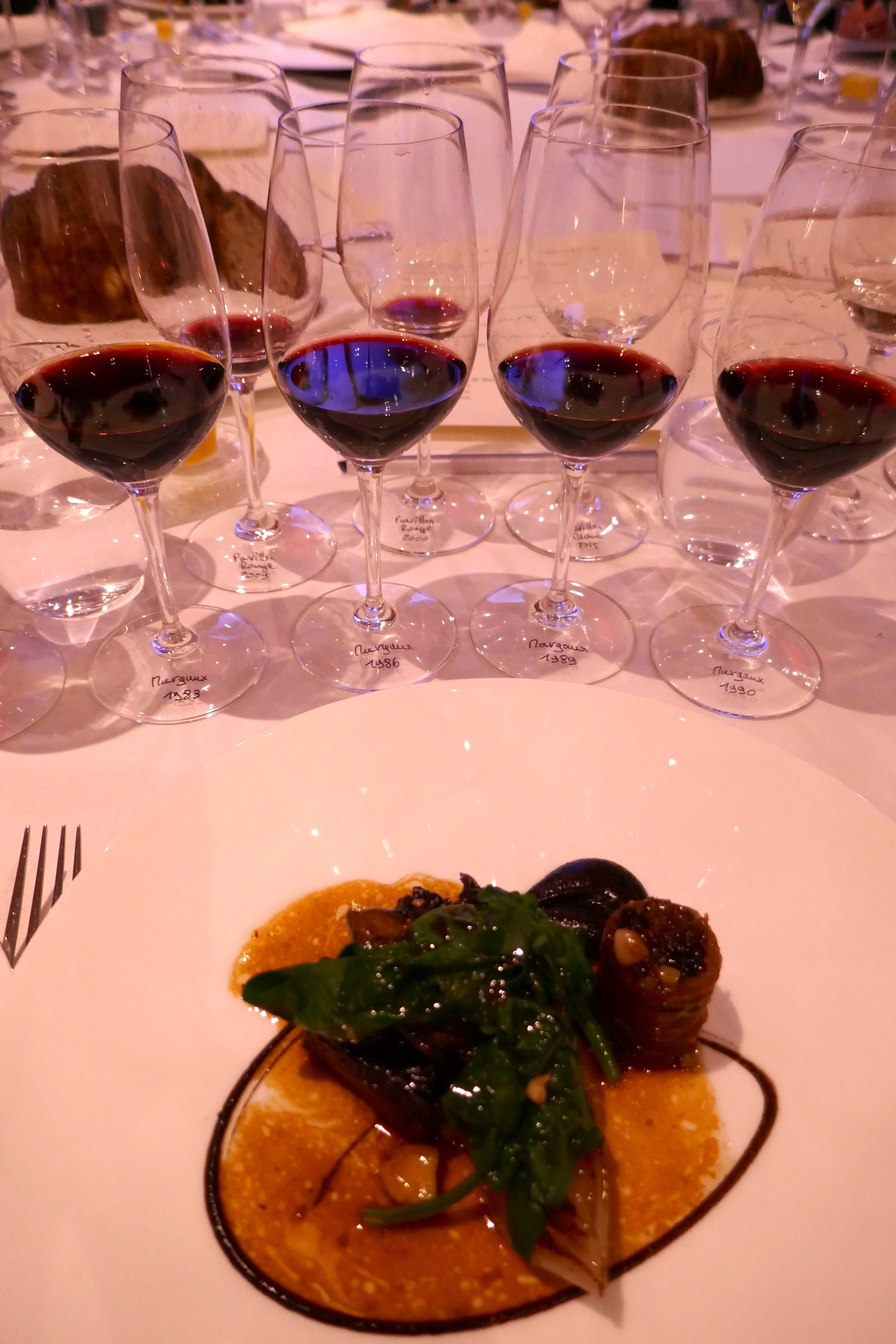
Margaux 1983
Aromatically expressive, a spiced attack preludes a charming medium-weight classic claret of supreme elegance and harmony. A gentle finish that nevertheless remains very elegant and delightfully complete.
Now to 2023
93
Wine Owners view
A great drink for right now, majoring on Margaux’s famed subtlety. Still possible to find in the secondary market around £350-£400 per bottle, which given its age and refinement is something of a steal. Hard to think of better First Growth value for money.
Margaux 1986
Heady, spiced, with a touch of iodine creating an intoxicating blend. Resolved on the palate, very good intensity allied to racy acidity. Fine scale with oranges and cloves on the long finish.
Now to 2025
95
Wine Owners view
1986 was a happy surprise due to the energy and resonance of the vintage. We wouldn’t keep it much longer but another strong buy for drinking around £400 per bottle.
Margaux 1989
Gorgeous overt nose, great length and grain, sappy with rising aromatics, a twist of liquorice and a cloved finish.
2020-2035
94+
Wine Owners view
The generosity of the vintage is evident on the nose, yet the accomplishments of this wine are still hidden, and there’s a sense of more to come. That grainy texture and gorgeous spiced finish are surely harbingers of great things in store for future drinking. As a result, a decent investment to boot for a 10 year view.
Margaux 1990
Saline, gamey nose and an energetic and velvet-textured attack, counter-balanced and infused with blood orange. Great resonance and breadth, visceral, spiced finish, and a whiff of very attractive sweet chloroform right at the finish. Very, very long. A great wine.
Now to 2030
98+
Wine Owners view
The velour and silky density of this wine makes it a beauty for enjoyment right now, and sure enough it was wine of the night for the majority of attendees. There’s more to go but will it ever be as lovely as it is now? Expect to pay £720+ per bottle so one for the collector who is looking for the very best vintages of Margaux.
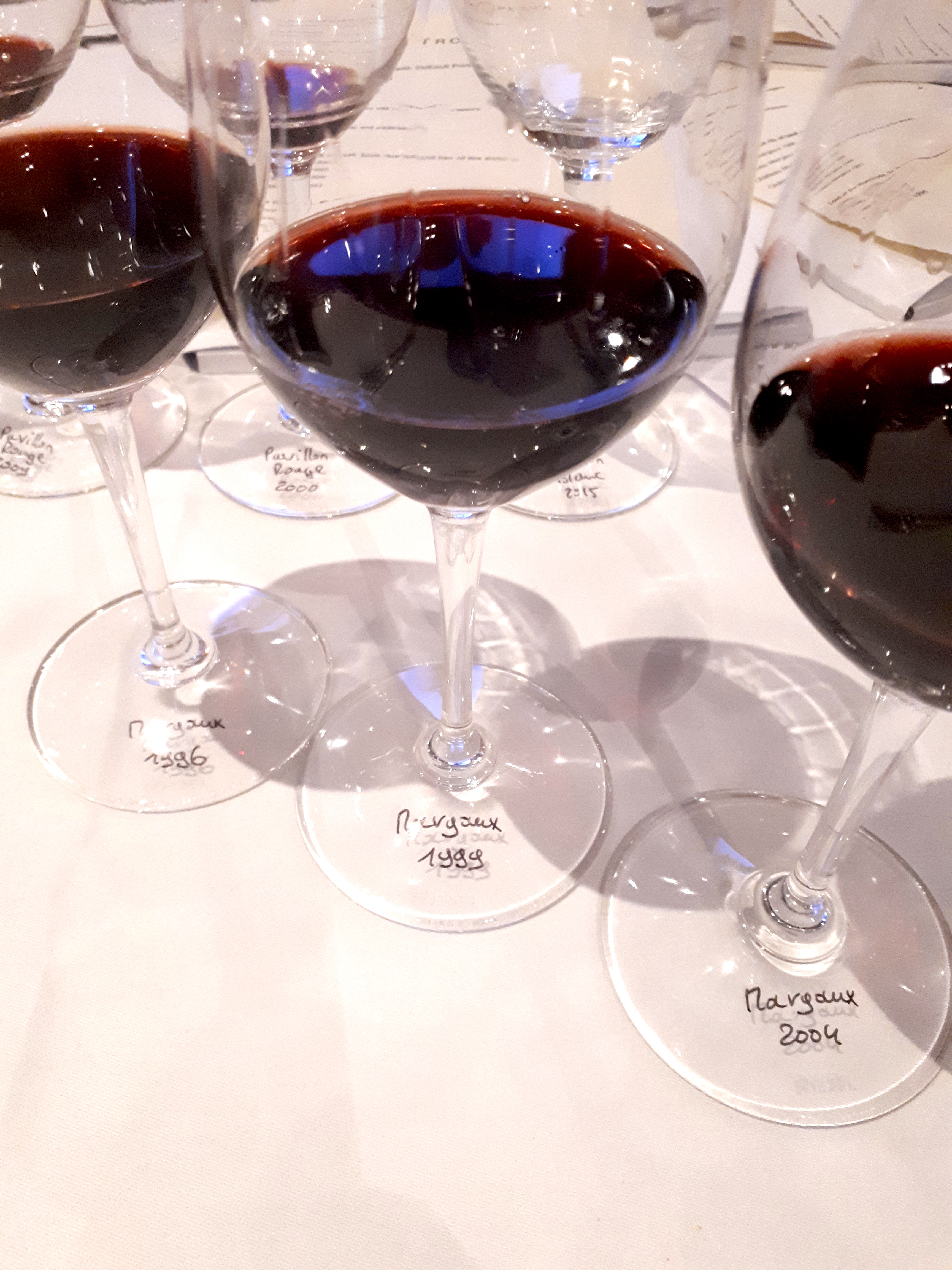
Margaux 1996
Svelte Nose, and then at the outset, so young and fresh. Tannins still present. A large scaled, monumental wine of extraordinary length yet extremely primary. An absolute baby in other words! With time in the glass the aromatics really open up. There is great intensity and a wonderful centre to this wine. Tonight 1990 gives more pleasure, but the sense of energy and drive in this wine along with all the other elements suggest a great, great Margaux in the making for 2025 onwards.
2025-2050
Wine Owners view
This is going to be mind-bendingly good. Though it lacks the resolution and some of the warmth of the 1990, it makes up for that in sheer energy, focus and intensity in its core. This elemental wine is still good value at around £500+ per bottle and would be an obvious choice as an investment, or buy now and wait 15 years to for a thrilling vinous experience as close as any gets to a concept of the perfect wine.
100
Margaux 2000 (Magnum)
A wine that is already resolved but at the beginning of its plateau. Spiced, cloves, sweet chloroform. Great energy, definition and depth on the finish, enlivened by a fine thread of acidity that uplifts the fruit. Very long and all the while gaining in energy through the impressive finish.
2018-2033
97
Wine Owners view
The overriding sense one has here is of harmony. Balanced and complete, spiced and heady with the signs of further maturity a short few years away. For many palates this is completely ready but an interesting addition to any Bordeaux lover’s cellar for its immediacy and near term potential.
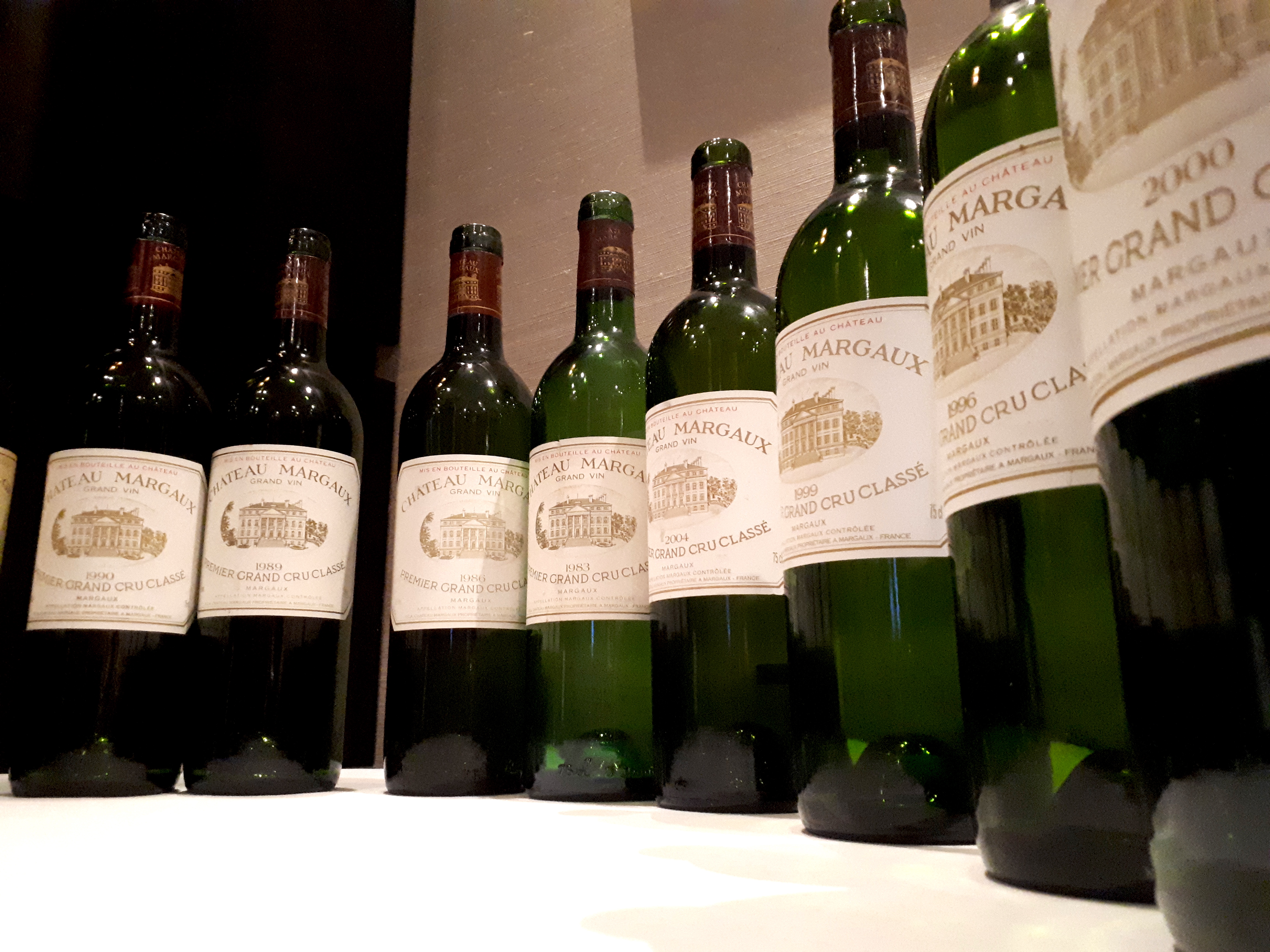
by Wine Owners
Posted on 2018-06-28
Whilst expensive Burgundies make the headlines, there's another revolution taking place that is transforming the qualitative level of winemaking more generally in Burgundy.
Revolution
It's a revolution that's very different to the one caused by an influx of corporate cash snapping up top domaines that produce some of the region’s most sought-after wines.
Daughters and sons who are graduating from l’école viticole, and who spend their stages at new world wineries or with progressive in-region vignerons, are taking best practises in the vines and chais back to familial domaines and transforming quality of those wines. Other offspring are going it alone, relying on their social network to buy grapes from friends and friends of family. And still others are coming back to their roots, turning their back on a career in Paris for the siren call of the Côte d’Or.
In a way there’s a relationship between the two; the big money coming in is offering the promise of a wealthier future to the next generation.
Must buys
Within this dynamic atmosphere there are lots of value buying opportunities. One doesn’t have to be a millionaire to own and to drink Burgundy. But you need to be quicker to claim an early allocation than previously. Prices of new discoveries rise fast. Whereas in the past it would have taken many vintages of successes before a domaine became established enough to justify rapid price hikes, these days positive press and ensuing price escalation can happen quickly.
How do I discover new producers?
Follow your favourite merchants – they’ll organise events or dinners at which the wines they represent can be tasted, allowing you to figure out which of the wines they are offering you think are the real deal.
Follow the critics – Neal Martin is now at Vinous, William Kelley has assumed the mantle at robertparker.com and Steen Öhman is busy discovering new talent at Winehog.
The blog format of Winehog is well suited to reading about new discoveries, where he’s picked up on Thibaud (Y) Clerget, Nicolas Faure, his fiancée Amelie Berthaut at Berthaut-Gerbet, Maxime Cheurlin at Georges Nöellat, Duroché, Jean-Marc Bouley, Arnaud Tessier, and Jean-Marc Vincent to highlight a range of notable domaines.
Charmes Dessus 2012, Domaine Tessier © Nick Martin
His latest discovery is Marthe Henri Boillot in Mersault, a true ‘start up’ having returned to pick up the remnants of her grandfather’s estate and has cut sourcing deals with friends.
It’s a familiar story. Down the road in Santenay Jean-Marc and Anne-Marie Vincent picked up the reins of his grandfather’s lapsed estate back in the late 1990s, and have transformed it into by far the best domaine of Santenay, making wines of great succulence, nerve and aromatic complexity. In fact, his reputation as one of the best true vignerons on the whole Côte is widely recognised by many other top producers all the way up into the Côte de Nuits.
They say birds of a feather flock together. Just look at Jean-Marc’s vigneron network, and you discover producers who share the same qualitative ethic and who are in search of constant improvements; producers such as Olivier Lamy, Jean-Marc Bouley and the passionately intense, super-fit Bruno Lorenzon in Mercurey.
Jean-Marc Vincent © Nick Martin
High density planting, low plant yields, vine training to minimise stress on the vine’s foot, braiding à la Leroy, soil microbial activity/ fertility, low sulphur addition late on in the winemaking process, rigorous triages of natural corks - are typical leitmotifs of these, and a growing number of young, ambitious producers.
In Vosne-Romanée, the brilliant and young family winemaker at Arnoux-Lachaux, Charles, has employed the braided training technique of his heroine Lalou-Bize Leroy to magical effect in his Aux Reignot vineyard, adding definition, an extraordinary energy and drive to this profound wine that is Grand Cru in everything but name. Arnoux Lachaux’s prices have skyrocketed so in that sense that particular ship has sailed; plenty are yet to leave port.
by Wine Owners
Posted on 2018-05-09
'Passion Asset' is a phrase of two halves. Alongside all the asset-focused work we do here at Wine Owners, we try to indulge the passion-focused bit too. Jonathan Reeve returned today from five busy days touring and tasting around eastern Sicily. Below is a summary of the trip, and five suggestions for Sicilian wines worth adding to your cellar (with a 5 – 10 year drinking window).
Erupting with Pride
Sicily has confidently reinvented itself in the past fifteen years, and is clearly proud of its achievements. Bulk blending wines have now been moved firmly to the background, and the island’s wineries are focusing their attention (and ours) firmly on quality wines and regional styles. Nowhere is the pride more obvious than around Etna. It seems so overt there that it borders on a sense of superiority, forgivable only because of the wines’ clear quality and First floors’ lofty perspective over the rest of the island. Etna remains the island's flagbearer, its wines a clear step or two ahead of the other regions in the charge towards quality and international recognition. Etna wines are blessed with pure fruit flavours, stunning ruby-like colouring, and the excellent acidity which is a signature of volcanic soils.
Wild and high atop Etna, Cornelissen’s volcanic ‘Magma’ Vineyard (900m)
©Jonathan Reeve
There is a sense of competition on Etna, with a handful of the top wineries quietly jockeying for the very top spot. Happily, their stylistic differences mean there is room at the top for them all; elegant Benanti, classic Graci, pure Torre Mora, bold Terre Nere, natural Cornelissen. We spent three days around Etna, mostly around the northern side where the best (blackest) terroir is to be found. One sunny afternoon we sampled the various and varied crus of Frank Cornellissen (whose ‘Munjebel CS’ shows just how Burgundy-like Etna wines can be, but whose wines have not yet proved themselves cellar-worthy), and those of the Tenuta delle Terre Nere (whose sexy Santo Spirito features among my suggested purchases below).
Among our gracious hosts during the visit was Antonio Benanti, who spent four full hours guiding us around his vineyards and wines. The quality and ageing potential of Benanti's Etna wines was abundantly clear, as was his focused, classic winemaking style.

A classic Rovittello label; Benanti before it was ‘Benanti’
©Jonathan Reeve
The stand-out wine from Benanti's range was the Etna Rosso from his vineyard in Rovittello. Rovittello is clearly a village to watch; Torre Mora's vineyard and winery is also there, and the high quality of their Etna Rosso from 2015 and 2016 was undeniable. The little-known Torre Mora estate was acquired in 2016 by Tenute Piccini of Tuscany, and given a very classy upgrade. Viticulture and winemaking have both been overhauled, with clear results, and the wine style brought up-to-date to a fresher, vibrant, more-classic wine style. Complimenti Piccini.
,
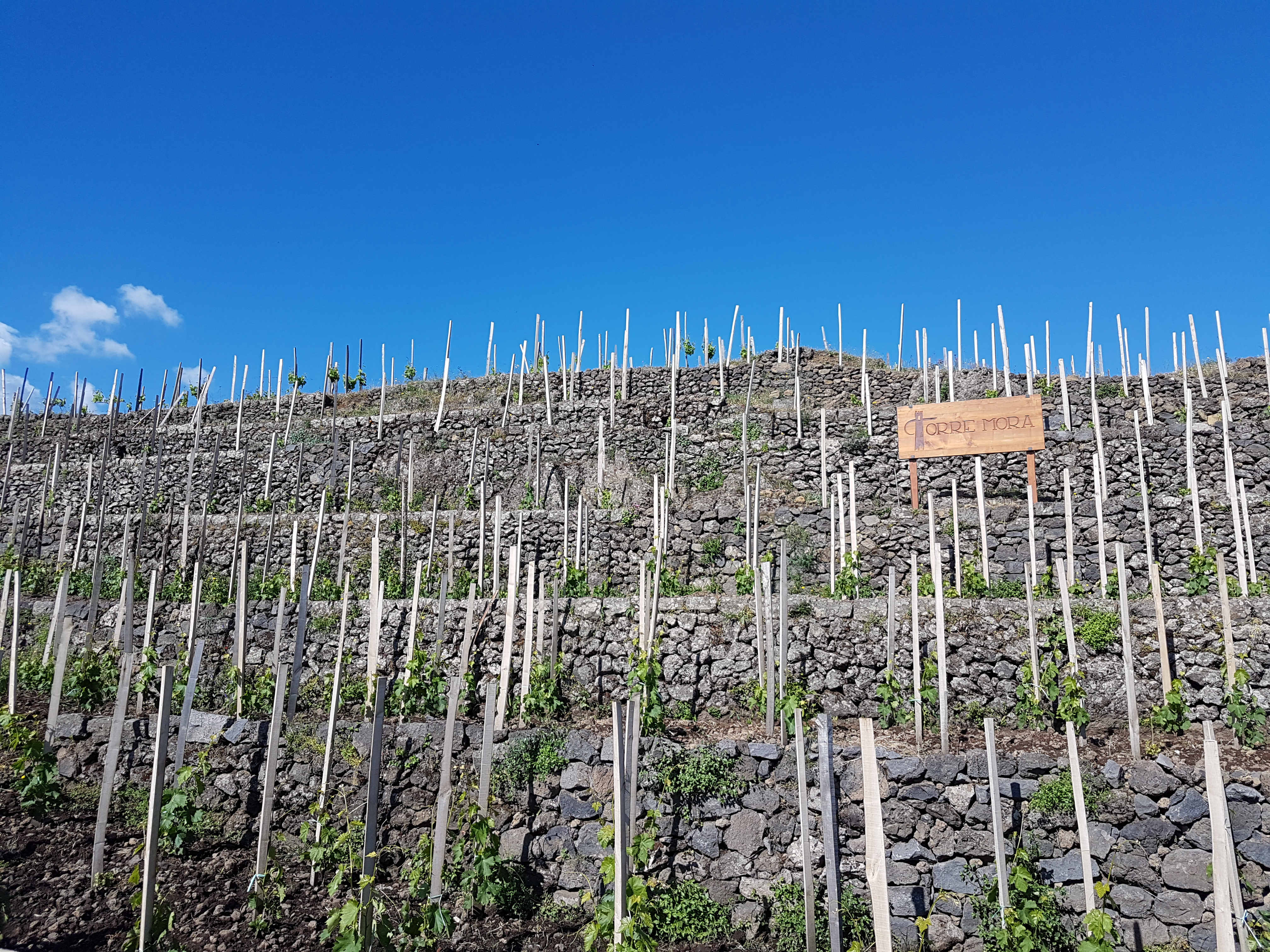
Rejuvenated: Tenuta Torre Mora, Rovittello
©Jonathan Reeve
No Wine Is an Island
Sicily has a broad range of wine styles – and more importantly clear distinctions between those styles. Also vital is that these styles work together; they complement one another, rather than competing. Fresh, crisp, elegant Etna Bianco is clearly distinct from broader-styled Inzolia-Chardonnay IGT blends and citrus-tropical Cattarratto varietals. Taut, bright, ruby-like Etna Rosso is a world apart from the dark, plummy Nero d'Avolas made in the island’s south-eastern corner, and another world again from the juicy, mouthwatering Cerasuolos from Vittoria (these combine Nero d'Avola's brooding depths with Frappato's ripe-strawberry brightness). Add to this core the island’s traditional trademarks – fortified Marsala and sweet Muscats from Pantelleria and Noto – and you have crystal-clear stylistic diversity that any region would be proud of. The wildcards in the pack were the handful of dry Moscato wines we tried. These were an unexpected surprise –refreshing in every regard. First was Planeta’s super-refreshing, aromatic Allemanda, and then COS’ amphora wine Zibbibo-in-Pithos, which calls to mind orange blossom and Earl Grey tea.
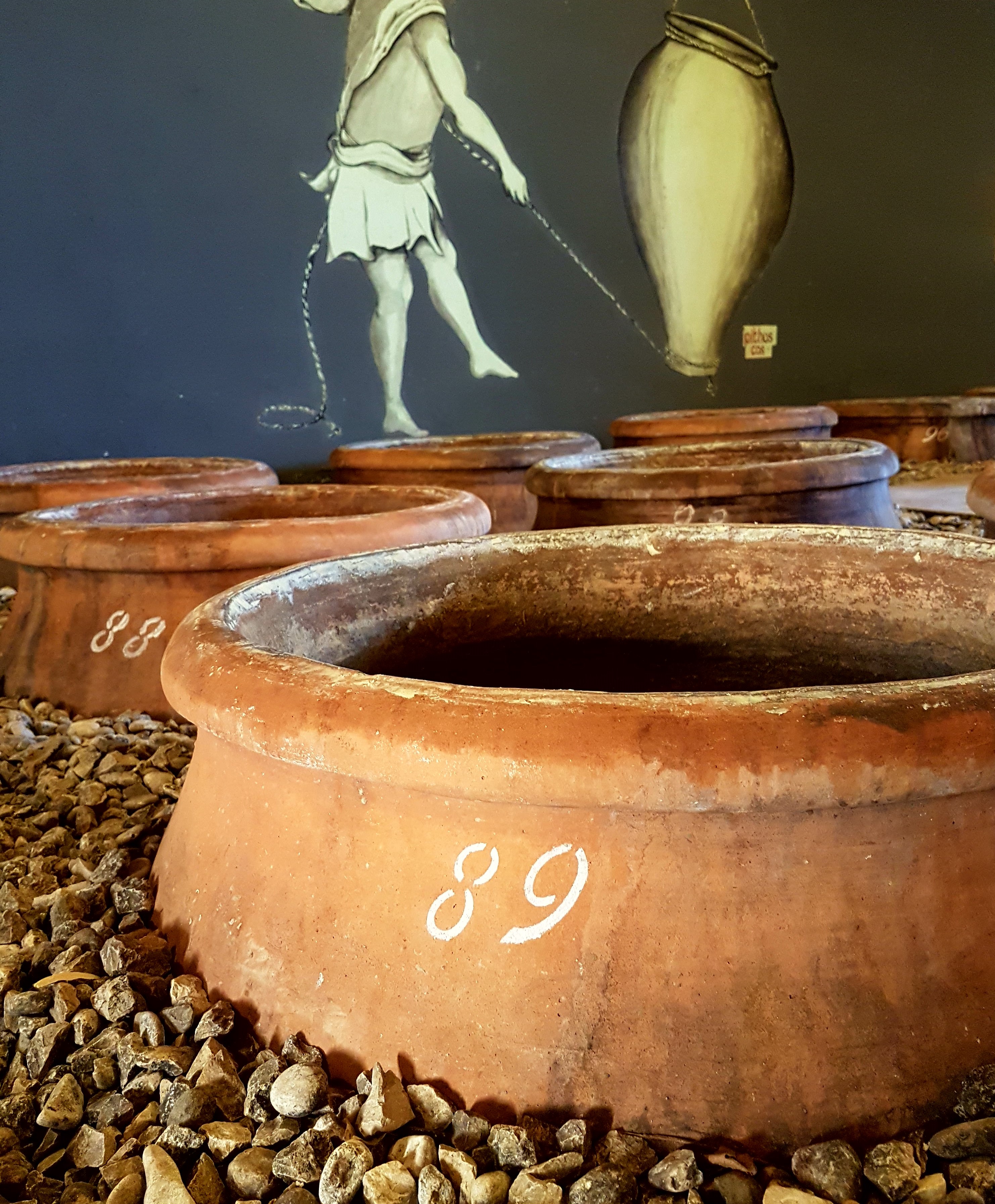
Amphorae at COS. Definitely not jug wine.
©Jonathan Reeve
Sicilians Don't Shrug
Marketing is key to Sicily's new look, and the island is doing it with flair. The island is more than just 'shrugging off' its old reputation. Those shoulders are shimmying with Mediterranean style, brilliantly exemplified by Donnafugata’s colourful labels. A visit to a Sicilian wine shop is like a visit to an art gallery. Many of the top wineries are hot on hospitality, too, with comprehensive tours and tastings available, and an increasing number offering accommodation (we stayed for two nights at a chic farmstay owned by the Occhipinti family). Planeta stood out on the hospitality front; our morning visit to their Buonivini estate was guided with expertise and generosity. We specifically requested to taste a few back-vintages of Cerasuolo di Vittoria and reds from Noto, to assess their cellaring potential. A cluster of wines from 2005 to 2015 soon appeared, and confirmed that top-level wines from both of these DOCs are indeed capable of developing for over a decade. One clear pattern was that the aromas and palate take on lives quite distinct from one another over the years; the 2005 Santa Cecilia Noto had a savoury nose of black olives and herbs, but retained noticeable fruity flavours on the palate. The lifespan of Sicilian wines will almost certainly increase in the coming years, as Sicily’s new generation of quality-focused winemakers continues to find its groove. This does beg one question, though…will the lively, soulful marketing and label designs disappear once the wines get more serious? Let’s hope not.
Five Sicilian Wines Worthy of Your Cellar
- Planeta Dorilli Cerasuolo di Vittoria Classico 2015
Drink 2018 – 2023
See Wine-Searcher
- Cos Cerasuolo di Vittoria Classico 2013
Drink 2018 – 2023
See Wine-Searcher
- Benanti Pietramarina Bianco 2016
Drink 2019 – 2029
Contact Benanti and tell them I sent you: info@benanti.it
- Torre Mora Etna Rosso 2015
Drink 2019 – 2025
Not yet released. Contact: info@tenutepiccini.it
- Terre Nerre Santo Spiritu 2015
Drink 2019 –2025
See Wine-Searcher
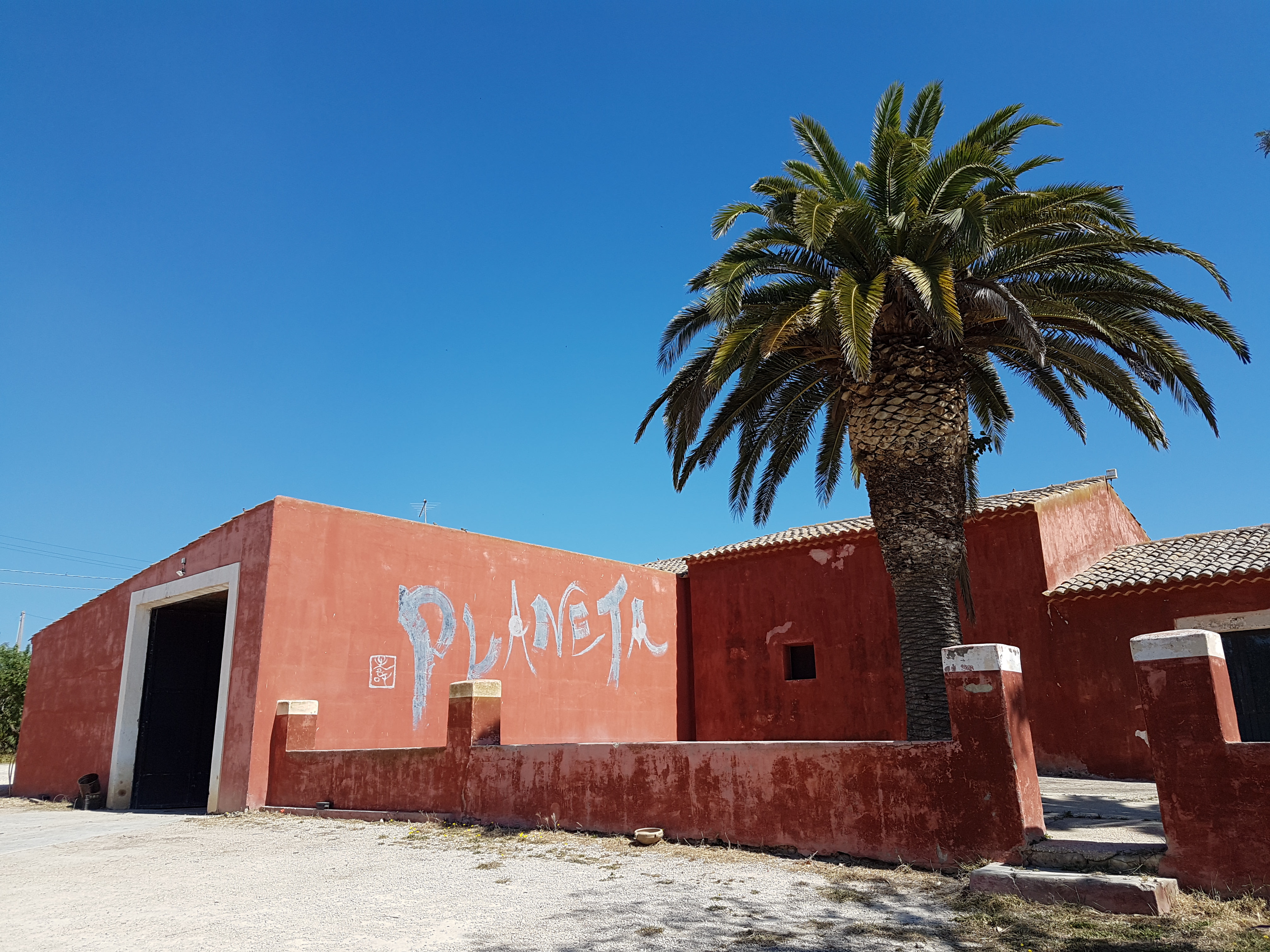
Planeta Buonivini Estate, Noto
©Jonathan Reeve
by Wine Owners
Posted on 2018-02-09
Today’s post comes from Jonathan Reeve, Wine Owners’ newest team member. Jonathan joined us in January, after eight busy years at Wine-Searcher.com. You can reach him, if you feel so inclined, at Wine Owners HQ: +44 (0)2072784377
Yes ladies and gentlemen, V-day is imminent, but no we are not going to feed you a regurgitated list of the ‘best Valentines wines to buy for your loved one’. We are instead devoting this post to a quick look at Passion Assets. Topical and actually interesting. And profitable.
They’re big news, and we’re hearing about them more and more. They’re becoming more…well, passionable. So what are passion assets? And why is wine the best passion asset?
Quick definition: Passion assets are essentially high-value luxury products such as fine wine, vintage watches, classic cars and antiques, which can be invested in for profit. Although originally created for some practical or aesthetic function, over time these products acquire a purely abstract financial value, born of a shared appreciation among the collective group of x lovers (wine lovers, watch lovers, car lovers etc.).
Passion assets are purchased initially because they have an emotional attachment, and are attractive in some way; they’re beautiful to taste, hold or look at. But because their value is simultaneously concrete and abstract, they are both a good store of wealth and a profitable investment. In truth, their investment performance is almost a coincidence. But what a beautiful coincidence that is. And there’s your answer; that’s why they’re quite so popular;
Since 2008 interest in tangible assets has grown massively. Rock-bottom interest rates and fears of market volatility have led investors to switch to investments which they can actually hold or touch, whose reality is more than just zeros and ones of stock market computer code. And what do those investors turn to when selecting these tangible assets? Things that they’re passionate about. Passion assets. Wine tops the list.
“Wine is the best passion asset.” Well, I would say that – I have wine passion. But genuinely, I mean it. I also have watch passion, and car passion, but I don’t invest in either of those. Investment wines may well be the only passion asset whose investment value begins from day one. Cars don’t become classics, watches don’t become ‘vintage’, and antiques don’t become antique until years after the initial purchase. Top-end investment wines, however, begin acquiring value from day one, as they leave the winery forecourt. If only cars did that…
It isn’t just me saying all this, either. Knight Frank say it too. Their Wealth Report 2017 confirmed wine as the world’s best-performing passion asset. Have a look at the Knight Frank Fine Wine Icons Index.
And here’s another reason. Which other passion asset gives you the opportunity to create such a diverse, romantic collection as wine? Not to mention flavourful. Every vintage brings several hundred products to select from and obsess over. Most collectors have their personal favourite producers, on top of the core handful which are mutually agreed by all as the ‘blue chip’ investment wines. And laid over this is the added dimension of the vintages themselves, dating back many decades, and even centuries in some exceptional cases. It’s hard to understate the power of a good vintage to spark adrenaline in wine collectors and investors.
And one last reason. Wine is more than the world’s most profitable passion asset; it’s also the most widely collected, and therefore one of the most stable. Win, win, win.
You get the picture. I think wine is a pretty excellent investment. If none of my points above have swayed you to my point of view, consider the following. If it all goes wrong, and the world pulls itself to pieces, as the warheads soar overhead and the bullets whizz past, would you rather sit in an antique chair counting down the seconds on an old watch, or would you rather pour and enjoy a glass of fantastic wine. Think about it. Happy Valentines Day.
P.S. If you really must hunt out a Valentine-themed wine, try Calon Ségur. It has a heart on the label, and happens to be performing very well as a passion asset.
